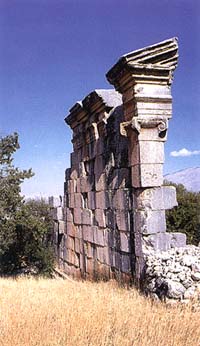The
Sacred
Mountain
At
2,745
meters,
this
is
the
second
highest
peak
in
Lebanon
after
the
3,083
meter-high
Qornet
El-Sawda
in
the
North.
The
mountain
was
known
to
the
Phoenicians
as
Sirion
and
the
Old
Testament
referred
to
it
as
Hermon.
This
was
a
sacred
mountain,
one
of
the
centers
of
the
ancient
tradition
of
worship
in
high
places.
Today
it
is
known
ass
Jabal
al-Shaykh.
In Roman times, Mt. Hermon, like Mt. Carmel and Mt. Cassius, was regarded as a holy place and the residence of a god. Not surprisingly, numerous temples rose up on its slopes. Traces of a pagan cult can still be found on the second summit, Qasr Antar. This cone-shaped peak rising five to six meters high, is encircled by an oval stone barrier.

Connected with this sacred enclosure is a small temple to the south, whose moldings indicate that it was built in the Roman period. The cone has been especially adapted to serve as a geodetic reference mark. The rock is hollowed out to form a basin wall three and a half meters in diameter. Ritual processions probably took place around the sacred peak, a practice common among the Semites. St, Jerome relates that even in his lifetime (347-420 AD), people climbed to the summit to make their scacrifices.
The modern traveler will have no trouble appreciating the importance of this mountain in ancient times, for even today it stands above the South Beqaa valley as a major presence. Under snow in winter and spring, Mt. Hermon lends a wonderful contrast to the verdant landscape around it.
(BEIRUT - BYBLOS - JEITA GROTTO - TRIPOLI - SIDON - ZAHLÉ)
(AANJAR - THE CEDARS - TYRE - BAALBECK)
EGYPT - SYRIA - JORDAN